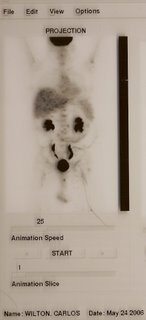 This morning I pick up my PET Scan results from Jersey Shore University Medical Center. Unlike the CT Scan results, which consist of 20 or 25 poster-sized "films" (large transparencies that must be held up against a light source in order to view them), there are just two PET Scan films (small transparencies, about the size of a business letter). The PET Scan is based on a technology (Positron Emission Tomography) that tracks the radioactive glucose the technician injected into my veins. Because the glucose heads directly for areas of rapid metabolism – tumors, in other words – it's the best test for identifying where certain types of cancerous cells are located. I've been told the PET Scan causes malignancies to "light up" on the scan pictures, so they're plainly visible to the trained eye. The CT Scan may portray the body in high resolution, but the cloudy images of the PET Scan tell the doctors what type of tissue it is they're looking at. For that reason, it's incredibly valuable in cancer diagnosis and staging.
This morning I pick up my PET Scan results from Jersey Shore University Medical Center. Unlike the CT Scan results, which consist of 20 or 25 poster-sized "films" (large transparencies that must be held up against a light source in order to view them), there are just two PET Scan films (small transparencies, about the size of a business letter). The PET Scan is based on a technology (Positron Emission Tomography) that tracks the radioactive glucose the technician injected into my veins. Because the glucose heads directly for areas of rapid metabolism – tumors, in other words – it's the best test for identifying where certain types of cancerous cells are located. I've been told the PET Scan causes malignancies to "light up" on the scan pictures, so they're plainly visible to the trained eye. The CT Scan may portray the body in high resolution, but the cloudy images of the PET Scan tell the doctors what type of tissue it is they're looking at. For that reason, it's incredibly valuable in cancer diagnosis and staging.Leaving the radiology file room, I ride the elevator downstairs: but before leaving the building, I stop by a visitors' waiting area, sit down, and open the envelope. Along with the PET Scan films – which are interesting to look at, but impossible for an untrained person like me to read – there is a two-page narrative report. Reading quickly through it, I find these words:
"No pathologic anterior abdominal, retroperitoneum, pelvic or inguinal lymphadenopathy is identified. There has been interval resolution of the previously documented pathologic lymphadenopathy involving the mesentery, retroperitoneum, and left inguinal region. There is no scintographic correlate to the mesenteric/retroperitoneal soft tissue mass within the upper abdomen at the level of the renal pelves."
 I'm not familiar with all the anatomical terms, but I think I get the gist of it: there's no cancerous tissue visible on this PET Scan. Later, back home, I do some sleuthing on the internet, and puzzle out the meaning of all this medical jargon. "Lymphadenopathy" is the key word: it means "swollen lymph nodes." If there's "no pathologic lymphadenopathy," that means the swollen lymph-node tissue that is visible on the scan shows no sign of being malignant. The "mesentery, retroperitoneum, and left inguinal region" are the areas that were lit up on my first PET Scan, back in November – they are, respectively, an abdominal membrane, the back section of the abdomen and the left groin. On this week's PET Scan, these regions aren't lit up at all. The last sentence refers to the large, abdominal mass that's been the focus of the most attention: it says none of the radioactive tracer shows up inside the mass.
I'm not familiar with all the anatomical terms, but I think I get the gist of it: there's no cancerous tissue visible on this PET Scan. Later, back home, I do some sleuthing on the internet, and puzzle out the meaning of all this medical jargon. "Lymphadenopathy" is the key word: it means "swollen lymph nodes." If there's "no pathologic lymphadenopathy," that means the swollen lymph-node tissue that is visible on the scan shows no sign of being malignant. The "mesentery, retroperitoneum, and left inguinal region" are the areas that were lit up on my first PET Scan, back in November – they are, respectively, an abdominal membrane, the back section of the abdomen and the left groin. On this week's PET Scan, these regions aren't lit up at all. The last sentence refers to the large, abdominal mass that's been the focus of the most attention: it says none of the radioactive tracer shows up inside the mass.If this is what I think it is – the all-clear signal – there's reason for rejoicing. I try to curb my enthusiasm, though, until I get the high sign from an actual physician (other than the radiologist who read the scan and created all that lovely medical verbiage). The phone call comes about 8:00 p.m.: and while it's not Dr. Lerner on the other end of the line, it is Vanessa, one of the nurses who works in his office. She tells me, in plain English, that the PET Scan shows no sign of cancer in my body. The R-CHOP chemotherapy-and-Rituxan cocktail, it seems, has done its work beautifully.
This is good news indeed: but I know enough, from my background reading about lymphoma, to sound a note of caution. I'm not out of the woods yet. Every lymphoma tumor starts from a single cell. Just because my largest tumor has now shrunk down to scar tissue doesn't mean there aren't any lymphoma cells still roaming around my body. In explaining the need for radiation a few weeks ago, Dr. Lerner told us as much: there could still be a few lymphoma cells lurking in that mass, or elsewhere. The enemy army's been resoundingly defeated: but there could still be a few guerilla fighters hiding out in the back alleys.
Next week is an important one for me. On Tuesday, I'll haul all these films and reports up to Dr. Portlock at Memorial Sloan-Kettering. Then, on Wednesday, I'll sit down with Dr. Lerner and get his take on the situation. If both doctors recommend radiation, as a precautionary measure, the decision will be easy. If there's a difference of opinion, life could get really interesting.
But for now, there's reason for celebration. I could very well be in remission. Time will tell if I truly am.
"I waited patiently for the Lord;
he inclined to me and heard my cry.
He drew me up from the desolate pit,
out of the miry bog,
and set my feet upon a rock,
making my steps secure.
He put a new song in my mouth,
a song of praise to our God."
– Psalm 40:1-3a
